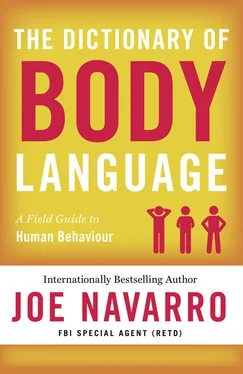At school I also began to discover the fascinating scientific underpinnings of many of these behaviors. To take just one example: in 1974 I got to see congenitally blind children playing together. It took my breath away. These children had never seen other children yet were exhibiting behaviors that I had thought were visually learned. They were demonstrating “happy feet” and the “steeple” with their hands, despite having never witnessed them. This meant these behaviors were hardwired into our DNA, part of our paleo-circuits—these very ancient circuits that ensure our survival and ability to communicate and are thus universal. Throughout my college career, I learned about the evolutionary basis of many of these behaviors, and throughout this book, I will reveal these often surprising facts we take for granted.
WHEN I FINISHED my studies at Brigham Young University, I received a phone call asking me to apply to the FBI. I thought it was a joke, but the next day two men in suits knocked on my door and handed me an application and my life changed forever. In those days, it was not unusual for FBI scouts to look for talent on campus. Why my name was handed up, or by who, I never learned. I can tell you that I was more than elated to be asked to join the most prestigious law enforcement agency in the world.
I was the second-youngest agent ever hired by the FBI. At the age of twenty-three I had again entered a new world. Though I felt unprepared in many ways to be an agent, there was one domain I had mastered: nonverbal communication. This was the only area where I felt confident. FBI work is, for the most part, about making observations. Yes, there are crime scenes to process and criminals to apprehend, but the majority of the job is talking to people, surveilling criminals, conducting interviews. And for that I was ready.
My career in the FBI spanned twenty-five years, the last thirteen of which I spent in the Bureau’s elite National Security Behavioral Analysis Program (NS-BAP). It was in this unit, designed to analyze the top national security cases, that I got to utilize my nonverbal skills as if on steroids. This unit, comprising just six agents selected from among twelve thousand FBI Special Agents, had to achieve the impossible: identify spies, moles, and hostile intelligence officers seeking to do harm to the United States under diplomatic cover.
During my time in the field I honed my understanding of body language. What I observed could never be replicated in a university laboratory. When I read scientific journals about deception and body language, I could tell that the authors had never actually interviewed a psychopath, a terrorist, a “made” Mafia member, or an intelligence officer from the Soviet KGB. Their findings might be true in a lab setting, using university students. But they understood little of the real world. No lab could replicate what I had observed in vivo, and no researcher could approximate the more than thirteen thousand interviews I had done in my career, the thousands of hours of surveillance video I had observed, and the behavioral notations that I had made. Twenty-five years in the FBI was my graduate school; putting multiple spies in prison based on nonverbal communications was my dissertation.
AFTER RETIRING FROM the FBI, I wanted to share what I knew about body language with others. What Every BODY Is Saying, published in 2008, was the product of that quest. In that book the concepts of “comfort” and “discomfort” took center stage, and I unveiled the ubiquity of “pacifiers”—such as touching our faces or stroking our hair—body behaviors we use to deal with everyday stress. I also sought to explain where these universal behaviors came from, drawing upon psychological research, evolutionary biology, and cultural contexts to explain why we do the things we do.
What Every BODY Is Saying became an international best seller; it has been translated into dozens of languages and has sold more than a million copies around the world. When I wrote What Every BODY Is Saying, I had no idea how popular it would become. At my speaking engagements in the years following its publication, I kept hearing the same thing: people wanted more, and they wanted it in a more easily accessible format. What many readers asked for was a field guide of sorts, a quick reference manual for behaviors they might encounter in day-to-day life.
The Dictionary of Body Language is that field guide. Organized by areas of the body—moving from the head down to the feet—it contains more than four hundred of the most important body-language observations I have made over the course of my career. My hope is that reading through The Dictionary of Body Language will give you the same insight into human behavior that I and other FBI agents have used to decode human behavior. Of course, we have used it when questioning suspects of crime. But you can use it as I have every day since I came to this country—to more fully understand those we interact with at work or at play. In social relationships, I can think of no better way to comprehend your friends or partners than by studying the primary means by which we communicate—nonverbally.
If you have ever wondered why we do the things we do, or what a particular behavior means, my hope is to satisfy your curiosity. As you go through the dictionary, act out the behaviors that you read about and get a sense for how they appear as well as they feel. By acting these out, you will better remember them the next time you see them. If you are like me and enjoy people watching, if you want to discern what people are thinking, feeling, desiring, fearing, or intending, whether at work, at home, or in the classroom, read on.

All behavior, of course, originates from inside the head. The brain is constantly at work, whether on a conscious or subconscious level. The signals that go out from the brain regulate the heart, breathing, digestion, and many other functions—but the exterior of the head is tremendously important as well. The hair, forehead, eyebrows, eyes, nose, lips, ears, and chin all communicate in their own way—from our general health to emotional distress. And so we begin with the part of the body that, from the time we are born until we die, we look to for useful information—first as parents, later as friends, work mates, lovers—to reveal for us what is in the mind.
1. HEAD ADORNMENT—Head adornment is used across all cultures for a variety of reasons. It can communicate leadership status (Native American chiefs’ feather headdresses), occupation (a hard hat or miner’s hat), social status (a bowler hat or an Yves Saint Laurent pillbox hat), hobbies (bicycle or rock-climbing helmet), religion (cardinal’s cap, Jewish yarmulke), or allegiance (favorite sports team, labor union). Head adornments may offer insight into individuals: where they fit in society, their allegiances, their socioeconomic status, what they believe, how they see themselves, or even the degree to which they defy convention.
2. HAIR—Sitting conveniently on top of the head, our hair conveys so much when it comes to nonverbal communication. Healthy hair is something all humans look for, even on a subconscious level. Hair that is dirty, unkempt, pulled out, or uncared for may suggest poor health or even mental illness. Hair attracts, entices, conforms, repels, or shocks. It can even communicate something about our careers; as renowned anthropologist David Givens puts it, hair often serves as an “unofficial résumé,” revealing where one ranks in an organization. And in many cultures hair is critical to dating and romance. People tend to follow both cultural norms and current trends with their hair; if they ignore these societal standards, they stand out.
Читать дальше













